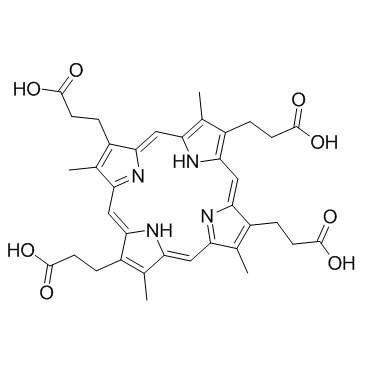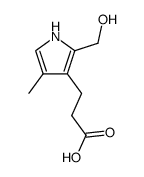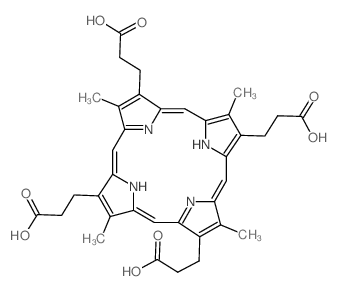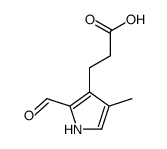Coproporphyrin III

Coproporphyrin III structure
|
Common Name | Coproporphyrin III | ||
|---|---|---|---|---|
| CAS Number | 14643-66-4 | Molecular Weight | 654.71 | |
| Density | 1.366 g/cm3 | Boiling Point | 1258ºC at 760 mmHg | |
| Molecular Formula | C36H38N4O8 | Melting Point | N/A | |
| MSDS | N/A | Flash Point | 714.6ºC | |
Use of Coproporphyrin IIICoproporphyrin III is a porphyrin derivative. |
| Name | coproporphyrin III |
|---|---|
| Synonym | More Synonyms |
| Description | Coproporphyrin III is a porphyrin derivative. |
|---|---|
| Related Catalog | |
| Target |
Human Endogenous Metabolite |
| In Vitro | Coproporphyrin III methyl ester is repeatedly isolated in considerable amount from both feces and urine. A great increase of coproporphyrin III excretion is unaccompanied by symptoms or signs of porphyria, metal or chemical poisoning or liver disease[1]. Primary cultures of chick embryo hepatocytes have been used to study the mechanism by which chemicals cause accumulation of intermediates of the heme synthetic pathway. In the presence of the porphyrin precursor, 5-aminolevulinate (ALA), addition of insulin causes a striking increase in accumulation of uroporphyrin I and coproporphyrin III. Antioxidants abolishes the uroporphyrin I accumulation and increases coproporphyrin III[2]. |
| In Vivo | Urinary DMA and porphyrin profile can be used as an early warning biomarker for chronic MMA exposure before the onset of cancer. After 4 weeks the level of coproporphyrin III concentration significantly increases in all the treatment groups compared to the control[3]. |
| References |
| Density | 1.366 g/cm3 |
|---|---|
| Boiling Point | 1258ºC at 760 mmHg |
| Molecular Formula | C36H38N4O8 |
| Molecular Weight | 654.71 |
| Flash Point | 714.6ºC |
| PSA | 205.50000 |
| LogP | 4.69760 |
| Vapour Pressure | 0mmHg at 25°C |
| Index of Refraction | 1.638 |
| Storage condition | 2-8℃ |
|
Section 1: Product Identification Chemical Name:Coproporphyrin III dihydrochloride CAS Registry Number:14643-66-4 Formula:C36H38N4O8.2HCl EINECS Number:none Chemical Family:porphine (porphyrin) ligand Synonym:None
Section 2: Composition and Information on Ingredients IngredientCAS NumberPercentACGIH (TWA)OSHA (PEL) Title Compound14643-66-4100%no datano data Section 3: Hazards Identification Emergency Overview:No particular hazard associated with this material. Primary Routes of Exposure:Ingestion, inhalation Eye Contact:May cause slight to mild irritation of the eyes. Skin Contact:May cause slight to mild irritation of the skin. Inhalation:May be irritating to the nose, mucous membranes and respiratory tract. Ingestion:No specific information is available on the physiological effects of ingestion. Acute Health Affects:May be irritating to skin, eyes and respiratory tract. Chronic Health Affects:No information available on long-term chronic effects. NTP:No IARC:No OSHA:No SECTION 4: First Aid Measures Immediately flush the eyes with copious amounts of water for at least 10-15 minutes. A victim may need Eye Exposure: assistance in keeping their eye lids open. Get immediate medical attention. Wash the affected area with water. Remove contaminated clothes if necessary. Seek medical assistance if Skin Exposure: irritation persists. Remove the victim to fresh air. Closely monitor the victim for signs of respiratory problems, such as difficulty Inhalation: in breathing, coughing, wheezing, or pain. In such cases seek immediate medical assistance. Seek medical attention immediately. Keep the victim calm. Give the victim water (only if conscious). Induce Ingestion: vomiting only if directed by medical personnel. SECTION 5: Fire Fighting Measures Flash Point:no data Autoignition Temperature:none Explosion Limits:none Extinguishing Medium:carbon dioxide, dry powder or foam If this material is involved in a fire, fire fighters should be equipped with a NIOSH approved, positive pressure Special Fire Fighting Procedures: self contained breathing apparatus and full protective clothing. Hazardous Combustion andIf involved in a fire this material may emit toxic organic fumes. Decomposion Products: Unusual Fire or Explosion Hazards: No unusual fire or explosion hazards. SECTION 6: Accidental Release Measures Spill and Leak Procedures:Small spills can be mixed with vermiculite or sodium carbonate and swept up. SECTION 7: Handling and Storage Handling and Storage:Store in a tightly sealed container. Keep away from heat and direct sunlight. SECTION 8: Exposure Controls and Personal Protection Eye Protection:Always wear approved safety glasses when handling a chemical substance in the laboratory. Skin Protection:Wear protective clothing and gloves. Ventilation:Material may form a fine dust. If possible, handle the material in an efficient fume hood. If ventilation is not available a respirator should be worn. The use of respirators requires a Respirator Respirator: Protection Program to be in compliance with 29 CFR 1910.134. Ventilation:Material may form a fine dust. If possible, handle the material in an efficient fume hood. Additional Protection:No additional protection required. SECTION 9: Physical and Chemical Properties Color and Form:purple xtl. Molecular Weight:727.64 Melting Point:no data Boiling Point:no data Vapor Pressure:no data Specific Gravity:no data Odor:none Solubility in Water:soluble SECTION 10: Stability and Reactivity Stability:air and moisture stable solid Hazardous Polymerization:no hazardous polymerization Conditions to Avoid:none Incompatibility:oxidizing agents Decomposition Products:carbon dioxide, carbon monoxide, nitrogen oxides, and organic fumes SECTION 11: Toxicological Information RTECS Data:No information available in the RTECS files. Carcinogenic Effects:No data available Mutagenic Effects:No data available Tetratogenic Effects:No data available SECTION 12: Ecological Information Ecological Information:No information available SECTION 13: Disposal Considerations Disposal:Dispose of according to local, state and federal regulations. SECTION 14: Transportation Shipping Name (CFR):Non-hazardous Hazard Class (CFR):NA Additional Hazard Class (CFR):NA Packaging Group (CFR):NA UN ID Number (CFR):NA Shipping Name (IATA):Non-hazardous Hazard Class (IATA):NA Additional Hazard Class (IATA):NA Packaging Group (IATA):NA UN ID Number (IATA):NA SECTION 15: Regulatory Information TSCA:Not listed in the TSCA inventory. SARA (Title 313):Not reportable under SARA Title 313 Second Ingredient:none SECTION 16 - ADDITIONAL INFORMATION N/A |
|
~% 
Coproporphyrin III CAS#:14643-66-4 |
| Literature: Tetrahedron Letters, , vol. 46, # 50 p. 8669 - 8672 |
|
~% 
Coproporphyrin III CAS#:14643-66-4 |
| Literature: Tetrahedron Letters, , vol. 46, # 50 p. 8669 - 8672 |
|
~% 
Coproporphyrin III CAS#:14643-66-4 |
| Literature: Tetrahedron Letters, , vol. 46, # 50 p. 8669 - 8672 |
| 3,3',3'',3'''-(3,8,13,17-tetramethyl-porphyrin-2,7,12,18-tetrayl)-tetra-propionic acid |
| COPROPORPHYRIN III DIHYDROCHLORIDE |
| 3,3',3'',3'''-(3,8,13,17-Tetramethyl-porphyrin-2,7,12,18-tetrayl)-tetra-propionsaeure |
| 3,3',3'',3'''-(3,8,13,17-tetramethyl-21H,23H-porphine-2,7,12,18-tetrayl)-tetrakis-propionic acid |
| CoproporphyrinIII Dihyrochloride |
| 2,7,12,18-Tetramethyl-21H,23H-porphyrin-3,8,13,17-tetrapropionic acid |
| coproporphyrin |
| Coproporphyrin III |
| Coproporphyrin dihydrochloride |
| coproporphyriniii2HCl |
| 3,8,13,17-tetramethylporphyrin-2,7,12,18-tetrapropanoic acid |
| 3,8,13,17-TETRAMETHYL-21H,23H-PORPHINE-2,7,12,18-TETRAPROPIONIC ACID DIHYDROCHLORIDE |
| Koproporphyrin III |
| Coproporphyrin III dihydrochloride,3,8,13,17-Tetramethyl-21H,23H-porphine-2,7,12,18-tetrapropionic acid dihydrochloride |



![2-formyl-3-[2-(methoxycarbonyl)ethyl]-4-methylpyrrole structure](https://image.chemsrc.com/caspic/019/34463-53-1.png)